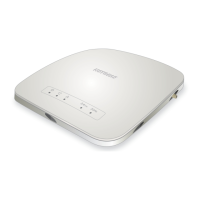Initial Setup
24
ProSAFE Dual-Band Wireless AC Access Points WAC720 and WAC730
6. Click the Apply button.
Your settings are saved.
Note: For information about how to configure advanced wireless settings,
see Configure Advanced Wireless Settings on page 78.
Test Basic Wireless Connectivity
After you configure the wireless access point, test the computers on your LAN for wireless
connectivity before you position and mount the wireless access point at its permanent
position.
To test for wireless connectivity:
1. Configure the wireless adapters of your computers so that they all use the same SSID
and channel that you configured on the wireless access point.
2. Verify that your computers acquired a wireless link to the wireless access point.
3. Verify network connectivity by using a browser such as Internet Explorer, Mozilla Firefox, or
Google Chrome to browse the Internet, or check for file and printer access on your network.
Note: If you experience trouble connecting to the wireless access point, see
Chapter 6, Troubleshooting.
We recommend that you complete the following tasks before you deploy the wireless access
point in your network:
• Configure wireless security and other wireless features as described in Chapter 3,
Wireless Configuration and Security.
• Configure any additional features that you might need as described in Chapter 4,
Management and Monitoring, and Chapter 5, Advanced Configuration.
11a mode only Data Rate From the menu, select the transmit data rate of the wireless
network. The default setting is Best. For a list of all options
that you can select from in 11a mode, see Factory Default
Settings on page 105.
Output Power From the menu, select the transmission power of the wireless access point: Full,
Half, Quarter, Eighth, Minimum. The default is Full.
Note: Increasing the power improves performance, but if two or more wireless
access points are operating in the same area and on the same channel,
interference can occur.
Note: Make sure that you comply with the regulatory requirements for total radio
frequency (RF) output power in your country.
Setting Descriptions

